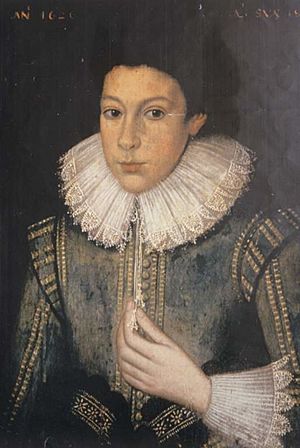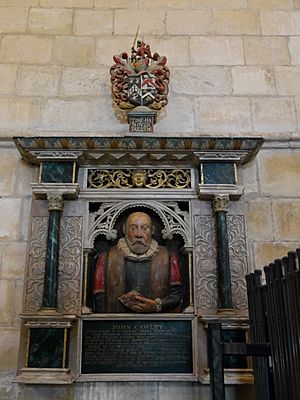William Cawley facts for kids
William Cawley (born 1602 – died January 1667) was an important English politician in the 1600s. He was involved in a major event in English history: the trial and execution of King Charles I. People who signed the King's death warrant are sometimes called "regicides."
William Cawley was born in Chichester in 1602. His father, John Cawley, was a successful brewer. William went to school at The Prebendal School in Chichester. He then studied at Oxford University and later at Gray's Inn, which is a place where people learn to become lawyers.
Contents
Early Life and Community Work
In 1625, William Cawley helped his community. He gave money to build special homes called almshouses. These homes were on the east side of New Broyle Road in Chichester. They were meant to provide a place to live for twelve local tradesmen who had fallen on hard times. Later, by 1681, these buildings were used as a "workhouse," a place where poor people could live and work.
William Cawley's Political Career
William Cawley became a Member of Parliament, which means he was elected to represent people in the English government. He was elected for Chichester in 1628. Later, in 1640, he was elected to represent Midhurst.
Role in King Charles I's Trial
In 1649, William Cawley was chosen to be part of the High Court of Justice. This court was set up to try King Charles I. Cawley attended all the meetings of the court. He was one of the people who signed the document that ordered King Charles I's execution. This was a very significant moment in English history.
Committee Work in Parliament
After the King's trial, Cawley was appointed to several important groups called "standing committees." These committees helped manage different parts of the government. He was on the army committee, which dealt with military matters. He also served on the committee for the advance of money, the committee for plundered ministers, and the committee for compounding. These committees handled various financial and administrative tasks for the government.
Council of State Membership
William Cawley continued to be an important figure in the government. He was elected to the Council of State in 1651. He was elected again to this powerful council in 1652. The Council of State was like a cabinet that helped run the country during this period.
Life After the Monarchy Returned
In 1660, the monarchy was brought back to England. This event is known as the English Restoration. King Charles II, the son of the executed king, returned to the throne. Many people who had been involved in his father's trial faced serious consequences.
Exile and Final Years
William Cawley was not pardoned by the new King. He had to leave England to avoid punishment. He first went to the Netherlands. After that, he moved to Switzerland. In Switzerland, he joined other people who had been involved in the King's trial, such as Edmund Ludlow and Nicholas Love. William Cawley passed away in Vevey, Switzerland, in 1667.
Family Life
William Cawley was married twice. His first wife was Catherine Walrond. They had four children together. Two of their notable children were William Cawley, who also became a Member of Parliament, and John Cawley, who became an important church official called the Archdeacon of Lincoln. His second wife was named Mary.



